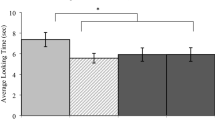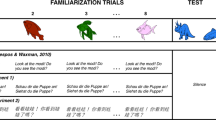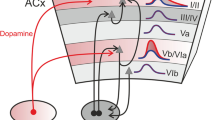Abstract
In natural languages, vowels tend to convey structures (syntax, prosody) while consonants are more important lexically. The consonant bias, which is the tendency to rely more on consonants than on vowels to process words, is well attested in human adults and infants after the first year of life. Is the consonant bias based on evolutionarily ancient mechanisms, potentially present in other species? The current study investigated this issue in a species phylogenetically distant from humans: Long–Evans rats. During training, the animals were presented with four natural word-forms (e.g., mano, “hand”). We then compared their responses to novel words carrying either a consonant (pano) or a vowel change (meno). Results show that the animals were less disrupted by consonantal alterations than by vocalic alterations of words. That is, word recognition was more affected by the alteration of a vowel than a consonant. Together with previous findings in very young human infants, this reliance on vocalic information we observe in rats suggests that the emergence of the consonant bias may require a combination of vocal, cognitive and auditory skills that rodents do not seem to possess.


Similar content being viewed by others
References
Acha J, Perea M (2010) On the role of consonants and vowels in visual-word processing Evidence with a letter search paradigm. Lang Cogn Process 25:423–438
Aslin RN, Newport EL (2012) Statistical learning from acquiring specific items to forming general rules. Current directions in psychological science 21(3):170–176
Benavides-Varela S, Hochmann J-R, Macagno F, Nespor M, Mehler J (2012) Newborn’s brain activity signals the origin of word memories. Proc Natl Acad Sci 109(44):17908–17913
Bergelson E, Swingley D (2012) At 6–9 months, human infants know the meanings of many common nouns. Proc Natl Acad Sci 109(9):3253–3258
Bertoncini J, Bijeljac-Babic R, Jusczyk PW, Kennedy LJ (1988) An investigation of young infants’ perceptual representations of speech sounds. J Exp Psychol Gen 117:21–33
Best CT, McRoberts GW, Sithole NM (1988) Examination of perceptual reorganization for nonnative speech contrasts: Zulu click discrimination by English-speaking adults and infants. J Exp Psychol Hum Percept Perform 14(3):345–360
Bonatti LL, Peña M, Nespor M, Mehler J (2005) Linguistic constraints on statistical computations: the role of consonants and vowels in continuous speech processing. Psychol Sci 16(6):451–459
Bonatti L, Peña M, Nespor M, Mehler J (2007) On consonants, vowels, chickens and eggs. Psychol Sci 18:924–925
Bouchon C, Toro J-M (2017) The origins of the consonant bias in word recognition: the case of Spanish-learning infants. In: Poster session presentation at the meeting of the 42th annual Boston University conference on language development, Boston, Massachusetts, USA
Bouchon C, Floccia C, Fux T, Adda-Decker M, Nazzi T (2015) Call me Alix, not Elix: vowels are more important than consonants in own name recognition at 5 months. Dev Sci 18(4):587–598
Caramazza A, Chialant D, Capasso R, Miceli G (2000) Separable processing of consonants and vowels. Nature 403(6768):428–430
Carreiras M, Price CJ (2008) Brain activation for consonants and vowels. Cereb Cortex 18(7):1727–1735
Carreiras M, Gillon-Dowens M, Vergara M, Perea M (2009a) Are vowels and consonants processed differently? ERP evidence with a delayed letter paradigm. J Cogn Neurosci 21:275–288
Carreiras M, Duñabeitia JA, Molinaro N (2009b) Consonants and vowels contribute differently to visual word recognition: ERPs of relative position priming. Cereb Cortex 19:2659–2670
Carreiras M, Vergara M, Perea M (2009c) ERP correlates of transposed-letter similarity effects: are consonants processed differently from vowels? Neurosci Lett 419:219–224
Christiansen M, Kirby S (2003) Language evolution. Oxford University Press, Oxford
Creel SC, Aslin RN, Tanenhaus MK (2006) Acquiring an artificial lexicon: segment type and order information in early lexical entries. J Mem Lang 54(1):1–19
Cutler A, Clifton CE (1999) Comprehending spoken language: a blueprint of the listener in neurocognition of language. Oxford University Press, Oxford, pp 123–155 (C. Brown; P. Hagoort)
Cutler A, Mehler J (1993) The periodicity bias. J Phon 21(1):103–108
Cutler A, Sebastiàn-Gallès N, Soler-Vilageliu O, van Ooijen B (2000) Constraints of vowels and consonants on lexical selection: cross-linguistic comparisons. Mem Cogn 28:746–755
de la Mora D, Toro JM (2013) Rule learning over consonants and vowels in a non-human animal. Cognition 126(2):307–312
Delle Luche C, Poltrock S, Goslin J, New B, Floccia C, Nazzi T (2014) Differential processing of consonants and vowels in the auditory modality: a cross-linguistic study. J Mem Lang 72:1–15
Dooling RJ, Best CT, Brown SD (1995) Discrimination of synthetic full-formant and sinewave /ra-la/ continua by budgerigars (Melopsittacus undulatus) and zebra finches (Taeniopygia guttata). J Acoust Soc Am 97(3):1839–1846
Duñabeitia JA, Carreiras M (2011) The relative position priming effect depends on whether letters are vowels or consonants. J Exp Psychol Learn Mem Cogn 37:1143–1163
Erickson ML (2000) Simultaneous effects on vowel duration in American English: a covariance structure modeling approach. J Acoust Soc Am 108(6):2980–2995
Eriksson J, Villa A (2006) Learning of auditory equivalence classes for vowels by rats. Behav Proc 73:348–359
Escudero P, Mulak KE, Vlach HA (2015) Crosssituational learning of minimal word pairs. Cogn Sci 40:455–465
Fitch WT (2005) The evolution of language: a comparative review. Biol Philos 20(2–3):193–203
Fitch WT, Hauser MD, Chomsky N (2005) The evolution of the language faculty: clarifications and implications. Cognition 97(2):179–210
Fry DB, Abramson AS, Eimas PD, Liberman AM (1962) The identification and discrimination of synthetic vowels. Lang Speech 5(4):171–189
Hallé PA, de Boysson-Bardies BD (1994) Emergence of an early receptive lexicon: infants’ recognition of words. Infant Behav Dev 17(2):119–129
Hallé PA, de Boysson-Bardies BD (1996) The format of representation of recognized words in infants’ early receptive lexicon. Infant Behav Dev 19:463–481
Hauser MD, Chomsky N, Fitch WT (2002) The faculty of language: what is it, who has it, and how did it evolve? Science 298(5598):1569–1579
Havy M, Serres J, Nazzi T (2014) A consonant/vowel asymmetry in word-form processing: evidence in childhood and in adulthood. Lang Speech 57(2):254–281
Hochmann J-R, Benavides-Varela S, Nespor M, Mehler J (2011) Consonants and vowels: different roles in early language acquisition. Dev Sci 14(6):1445–1458
Hochmann J-R, Benavides-Varela S, Fló A, Nespor M, Mehler J (2018) Bias for vocalic over consonantal information in 6-month-olds. Infancy 23(1):136–151
Jackendoff R, Pinker S (2005) The nature of the language faculty and its implications for evolution of language (Reply to Fitch, Hauser, and Chomsky). Cognition 97(2):211–225
Keidel JL, Jenison RL, Kluender KR, Seidenberg MS (2007) Does grammar constrain statistical learning? Commentary on Bonatti, Peña, Nespor, and Mehler (2005). Psychol Sci 18:922–923
Kewley-Port D, Burkle TZ, Lee JH (2007) Contribution of consonant versus vowel information to sentence intelligibility for young normal-hearing and elderly hearing-impaired listeners. J Acoust Soc Am 122(4):2365–2375
Kluender KR, Lotto AJ, Holt LL, Bloedel SL (1998) Role of experience for language-specific functional mappings of vowel sounds. J Acoust Soc Am 104(6):3568–3582
Kuhl PK (1981) Discrimination of speech by nonhuman animals: basic auditory sensitivities conducive to the perception of speech-sound categories. J Acoust Soc Am 70(2):340–349
Kuhl PK (1991) Human adults and human infants show a « perceptual magnet effect » for the prototypes of speech categories, monkeys do not. Percept Psychophys 50(2):93–107
Kuhl PK, Miller JD (1978) Speech perception by the chinchilla: identification functions for synthetic VOT stimuli. J Acoust Soc Am 63(3):905–917
Kuhl PK, Padden DM (1982) Enhanced discriminability at the phonetic boundaries for the voicing feature in macaques. Percept Psychophys 32(6):542–550
Kuhl PK, Padden DM (1983) Enhanced discriminability at the phonetic boundaries for the place feature in macaques. J Acoust Soc Am 73(3):1003–1010
Kuhl PK, Williams KA, Lacerda F, Stevens KN, Lindblom B (1992) Linguistic experience alters phonetic perception in infants by 6 months of age. Science 255:606–608
Ladefoged P (1993) A course in phonetics. Harcourt Brace Jovanovich College Publishers, San Diego
Ladefoged P (2001) Vowels and consonants: an introduction to the sounds of languages. Blackwell, Oxford
Lameira AR, Maddieson I, Zuberbülher K (2013) Primate feedstock for the evolution of consonants. Trends Cogn Sci 18(2):60–62
Lameira AR, Vicente R, Alexandre A, Campbell-Smith G, Knott C, Wich S, Hardus ME (2017) Proto-consonants were information-dense via identical bioacoustic tags to proto-vowels. Nat Hum Behav 1:0044
Lee HW, Rayner K, Pollatsek A (2001) The relative contribution of consonants and vowels to word identification during reading. J Mem Lang 44:189–205
Liberman AM, Delattre PC, Cooper FS, Gerstman LJ (1954) The role of consonant-vowel transitions in the perception of the stop and nasal consonants. Psychol Monogr General Appl 68(8):1–13
Liberman AM, Harris KS, Hoffman HS, Griffith BC (1957) The discrimination of speech sounds within and across phoneme boundaries. J Exp Psychol 54(5):358–368
Liberman AM, Cooper FS, Shankweiler DP, Studdert-Kennedy M (1967) Perception of the speech code. Psychol Rev 74(6):431–461
MacWhinney B (2000) The CHILDES project: tools for analyzing talk, 3rd edn. Lawrence Erlbaum, Mahwah
Maddieson I (1984) Patterns of sounds. Cambridge University Press, Cambridge
Malmierca M (2003) The structure and physiology of the rat auditory system. Int Rev Neurobiol 56:147–211
Mehler J, Peña M, Nespor M, Bonatti L (2006) The « soul » of language does not use statistics: reflections on vowels and consonants. Cortex 42(6):846–854
Morse PA, Snowdon CT (1975) An investigation of categorical speech discrimination by rhesus monkeys. Percept Psychophys 17(1):9–16
Murphy R, Mondragón E, Murphy V (2008) Rule learning by rats. Science 319:1849–1851
Näätänen R (2001) The perception of speech sounds by the human brain as reflected by the mismatch negativity (MMN) and its magnetic equivalent (MMNm). Psychophysiology 38(1):1–21
Nazzi T, Poltrock S, Von Holzen K (2016) The developmental origins of the consonant bias in lexical processing. Curr Dir Psychol Sci 25(4):291–296
Nespor M, Peña M, Mehler J (2003) On the different roles of vowels and consonants in speech processing and language acquisition. Lingue e linguaggio 2(2):203–230
New B, Nazzi T (2014) The time course of consonant and vowel processing during word recognition. Lang Cogn Neurosci 29(2):147–157
New B, Araújo V, Nazzi T (2008) Differential processing of consonants and vowels in lexical access through reading. Psychol Sci 19(12):1223–1227
Newport EL, Hauser MD, Spaepen G, Aslin RN (2004a) Learning at a distance II. Statistical learning of non-adjacent dependencies in a non-human primate. Cogn Psychol 49(2):85–117
Newport EL, Hauser MD, Spaepen G, Aslin RN (2004b) Learning at a distance II. Statistical learning of non-adjacent dependencies in a non-human primate. Cogn Psychol 49:85–117
Nishibayashi LL, Nazzi T (2016) Vowels, then consonants: early bias switch in recognizing segmented word forms. Cognition 155:188–203
Owren MJ, Cardillo GC (2006) The relative roles of vowels and consonants in discriminating talker identity versus word meaning. J Acoust Soc Am 119(3):1727–1739
Perez C, Engineer C, Jakkamsetti V, Carraway R, Perry M, Kilgard M (2013) Different timescales for the neural coding of consonant and vowel sounds. Cereb Cortex 23(3):670–683
Pisoni DB (1973) Auditory and phonetic memory codes in the discrimination of consonants and vowels. Percept Psychophys 13(2):253–260
Poltrock S, Nazzi T (2015) Consonant/vowel asymmetry in early word form recognition. J Exp Child Psychol 131:135–148
Pons F (2006) The effects of distributional learning on rats’ sensitivity to phonetic information. J Exp Psychol Anim Behav Process 32:97–101
Reed P, Howell P, Sackin S, Pizzimenti L, Rosen S (2003) Speech perception in rats: use of duration and rise time cues in labeling of affricate/fricative sounds. J Exp Anal Behav 80:205–215
Repp BH (1984) Categorical perception: issues, methods, findings in speech and language: advances in basic research and practice, vol 10. Academic Press, New York, pp 243–335
Rescorla R, Wagner A (1972) A theory of Pavlovian conditioning: the effectiveness of reinforcement and non-reinforcement. In: Black AH, Prokasy WF (eds) Classical conditioning II: current research and theory. Appleton, New York, pp 64–99
Saffran J, Newport EL, Aslin RN (1996a) Word segmentation: the role of distributional cues. J Mem Lang 35(4):606–621
Saffran JR, Aslin RN, Newport EL (1996b) Statistical learning by 8-month-old infants. Science 274(5294):1926–1928
Sharp DJ, Scott SK, Cutler A, Wise RJS (2005) Lexical retrieval constrained by sound structure: the role of the left inferior frontal gyrus. Brain Lang 92:309–319
Sinnott JM (1989) Detection and discrimination of synthetic English vowels by Old World monkeys (Cercopithecus, Macaca) and humans. J Acoust Soc Am 86:557–565
Sinnott JM, Kreiter NA (1991) Differential sensitivity to vowel continua in Old World monkeys (Macaca) and humans. J Acoust Soc Am 89(5):2421–2429
Soares AP, Perea M, Comesaña M (2014) Tracking the emergence of the consonant bias in visual-word recognition: evidence with developing readers. PLoS One 9(2):e88580
Stevens KN, Blumstein SE (1978) Invariant cues for place of articulation in stop consonants. J Acoust Soc Am 64(5):1358–1368
Swingley D (2005) 11-month-olds’ knowledge of how familiar words sound. Dev Sci 8(5):432–443
Tincoff R, Jusczyk PW (1999) Some beginnings of word comprehension in 6-month-olds. Psychol Sci 10(2):172–175
Tincoff R, Jusczyk PW (2012) Six-month-olds comprehend words that refer to parts of the body. Infancy 17(4):432–444
Toro JM, Nespor M, Gervain J (2016) Frequency-based organization of speech sequences in a nonhuman animal. Cognition 146:1–7
Tsuji S, Cristia A (2014) Perceptual attunement in vowels: a meta-analysis. Dev Psychobiol 56:179–191
van Oijen B (1996) Vowel mutability and lexical selection in English: evidence from a word reconstruction task. Mem Cogn 24(5):573–583
Vergara-Martinez M, Perea M, Marín A, Carreiras M (2011) The processing of consonants and vowels during letter identity and letter position assignment in visual-word recognition: an ERP study. Brain Lang 118:105–117
Vihman MM, Nakai S, DePaolis RA, Hallé P (2004) The role of accentual pattern in early lexical representation. J Mem Lang 50:336–353
Waters RA, Wilson WA (1976) Speech perception by rhesus monkeys: the voicing distinction in synthesized labial and velar stop consonants. Percept Psychophys 19:285–289
Werker JF, Tees RC (1984) Cross-language speech perception: evidence for perceptual reorganization during the first year of life. Infant Behav Dev 7:49–63
Wich SA, Krützen M, Lameira AR, Nater A, Arora N, Bastian ML et al (2012) Call cultures in orang-utans? PLoS One 7:e36180
Yip M (2006) The search for phonology in other species. Trends Cogn Sci 10:442–446
Zesiger P, Dupuis Lozeron E, Lévy A, Frauenfelder U (2012) Phonological specificity in 12- and 17-month old French-speaking infants. Infancy 17:591–609
Funding
This study was funded by funding from an European Union’s ERC Starting Grant (Ref: 312519, BioCon) and Spanish Ministerio de Economia Grant (PSI2013-44992-P) awarded to Juan Manuel Toro, and the Horizon 2020 research and program Individual Fellowship MARIE SkŁodowska-CURIE ACTIONS’ Grant (H2020-MSCA-IF-2015, Ref: 707996, Title: Speech-sound Processing in Infant Development and Evolution) awarded to Camillia Bouchon.
Author information
Authors and Affiliations
Contributions
CB designed the study, CB and JMT built the stimuli, analysed and interpreted the data, CB drafted the manuscript. Both the authors reviewed the manuscript. We thank Jean Remy Hochmann for valuable comments on a previous version of the manuscript and Aina Viles for running the experiments.
Corresponding author
Ethics declarations
Conflict of interest
Camillia Bouchon declares that she has no conflict of interest. Juan Manuel Toro declares that he has no conflict of interest.
Ethical approval
All applicable international, national, and/or institutional guidelines for the care and use of animals were followed.
Additional information
Publisher's Note
Springer Nature remains neutral with regard to jurisdictional claims in published maps and institutional affiliations.
Rights and permissions
About this article
Cite this article
Bouchon, C., Toro, J.M. Is the consonant bias specifically human? Long–Evans rats encode vowels better than consonants in words. Anim Cogn 22, 839–850 (2019). https://doi.org/10.1007/s10071-019-01280-3
Received:
Revised:
Accepted:
Published:
Issue Date:
DOI: https://doi.org/10.1007/s10071-019-01280-3




